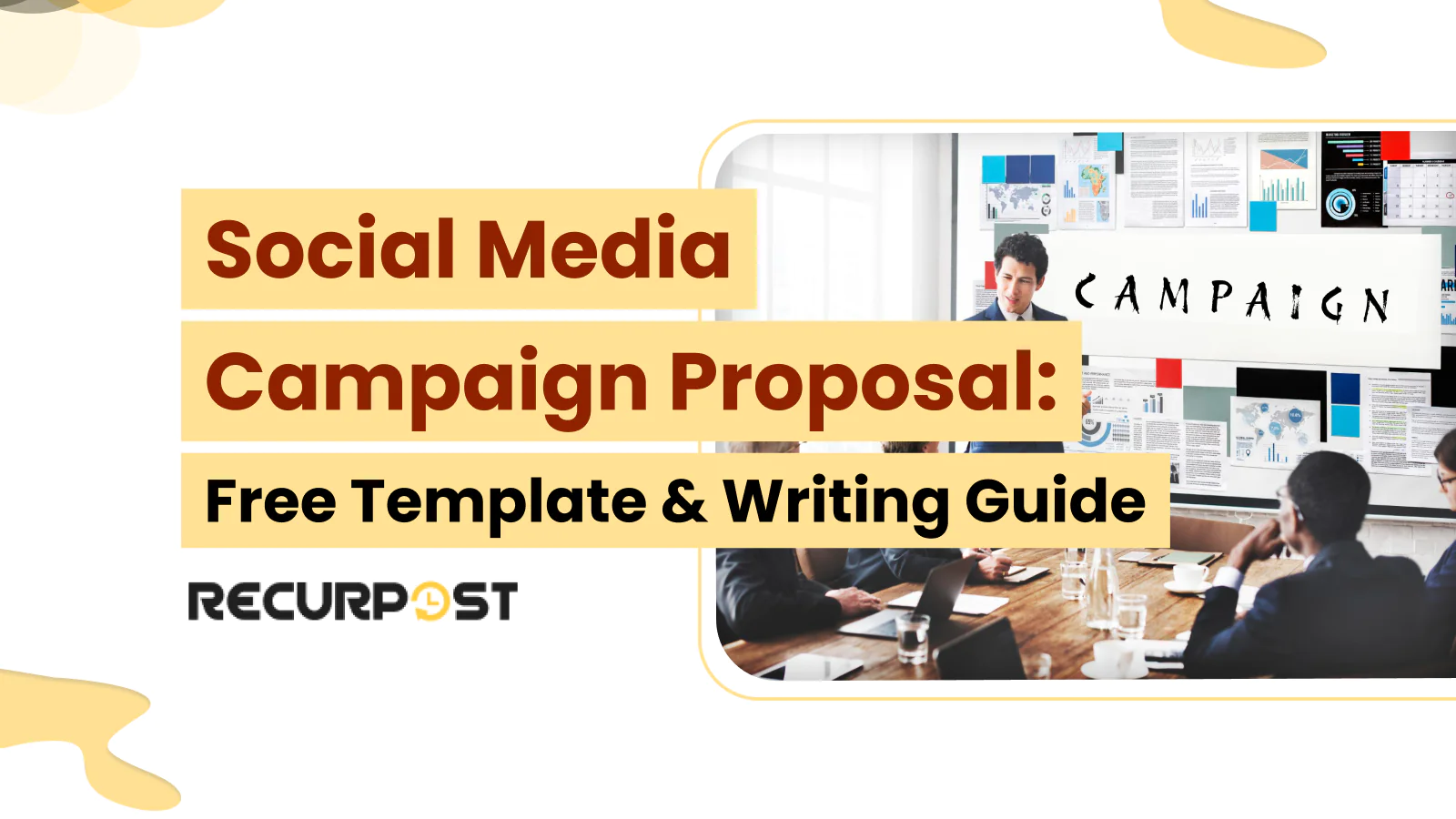Creating a compelling social media campaign proposal is necessary for any marketing agency or business aiming to enhance brand visibility and achieve measurable results. A well-structured social media marketing proposal serves as a strategic blueprint, connecting campaign objectives with client expectations and providing a clear roadmap for execution.
Businesses employing detailed proposals experience higher success rates. Companies integrating social media strategies into their proposals report a 45% greater success rate, demonstrating the effectiveness of well-planned campaigns.
This article provides insights and a free social media proposal template to help you craft proposals that win clients, boost engagement, and drive impactful campaigns.
What is a Social Media Campaign Proposal?
A social media proposal is a document that outlines the objectives, strategies, and performance metrics for social media initiatives. While a social media campaign proposal focuses on targeted marketing campaigns, other proposal types include social media management proposals for ongoing services, social media marketing proposals for broader marketing initiatives, and media plan proposals for strategic media buying. Each proposal type acts as a blueprint, providing clarity on how it will achieve business goals.
Why It’s Important
A strong social media proposal sets clear expectations between the marketing agency and the potential client. It helps secure client buy-in and approval by presenting a clear plan that demonstrates how the campaign will meet the prospective client’s business goals. This structured approach also enables the agency to manage resources effectively and track key performance indicators (KPIs) throughout the social media campaign’s lifecycle, ensuring measurable outcomes.
Download our Social Media Campaign Proposal Template, OR use an AI-generated tool to create your customized social media proposal and start with a solid plan for success.
Social Media Campaign Proposal Template
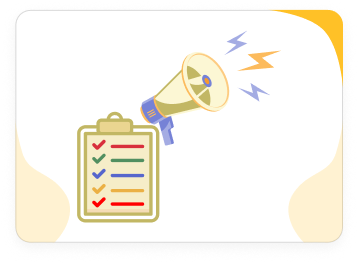
Types of Social Media Campaigns
Different social media campaign types serve unique business goals. Understanding these categories helps tailor proposals to clients’ specific needs. Common types include:

1. Brand Awareness Campaigns
Brand awareness campaigns increase visibility and recognition among wider audiences.
Example: A new skincare brand might run an Instagram campaign featuring testimonials from influencers, showcasing the product’s effectiveness to a broader audience.
2. Lead Generation Campaigns
Lead generation campaigns gather contact information from customers for future marketing efforts.
Example: An online course provider may offer a free webinar on LinkedIn, asking viewers to sign up with their email addresses to receive more educational resources.
3. Product Launch Campaigns
Product launch campaigns promote new products or services and drive immediate sales or engagement.
Example: A tech company launching a new smartphone might create a Twitter campaign with sneak peeks, countdowns, and pre-order offers to generate buzz and early purchases.
You develop a social media strategy proposal by analyzing client business objectives, conducting competitive research, defining target audience segments, selecting appropriate platforms based on audience behavior, creating content pillars aligned with brand goals, establishing measurement frameworks, and designing tactical approaches because each campaign type requires tailored strategies and tactics. Outlining the campaign purpose in the proposal ensures alignment with client objectives and social media goals.
How to Create a Social Media Campaign Proposal
A comprehensive social media campaign proposal directly impacts your client’s goals and the campaign’s success. The social media proposal outlines all actions and should address key objectives, target audiences, content strategies, and expected outcomes. Here’s an in-depth guide to building an effective social media marketing proposal:
1. Understand the Client’s Needs
Creating a social media campaign proposal begins with understanding the brand goals, current social media presence, and the target audience. This discovery process involves several key steps:
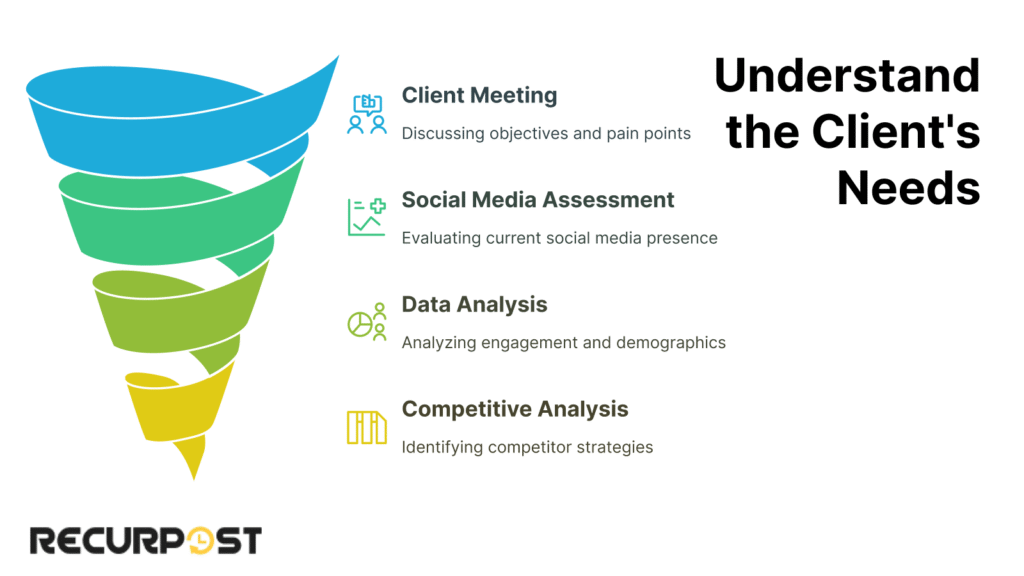
- Client Meeting: Start with a discussion about the client’s business objectives and pain points. Are they looking to increase brand visibility, drive website traffic, or improve audience engagement? Identifying their business goals early on will ensure that the social media proposal is aligned with these objectives.
- Current Social Media Presence: Assess how the client is currently engaging with their audience on social platforms. Which platforms are they active on? How frequently do they post? Are they using the right content types (e.g., video, images, articles)? Analyze this information to determine strengths and areas for improvement.
- Data Analysis: Utilize social media analytics tools such as Google Analytics, Facebook Insights, and Instagram Analytics to assess key metrics like engagement rates, traffic sources, and audience demographics. This will provide valuable insights into how well the current strategy is performing and identify opportunities for growth.
- Competitive Analysis: Conduct a detailed analysis of competitors’ social media strategies. Identify what’s working for them and where they might be falling short. This helps uncover gaps in the market and areas where the client can stand out.
Understanding client goals and current social media efforts ensures your proposal addresses their unique challenges.
2. Set SMART Goals

Clear goals drive successful social media campaigns. Clear, measurable objectives create a shared understanding of campaign achievements. McKinsey found that companies with coordinated marketing and sales goals achieve 3.4x higher conversion rates. Use SMART goals that are:
- Specific: Define exactly what the client hopes to achieve. For instance, “Increase Instagram engagement by 20%” or “Generate 100 new leads via LinkedIn in 60 days”.
- Measurable: Use metrics to track progress. Identify key performance indicators (KPIs) like engagement metrics, website traffic, conversion rates, or user-generated content.
- Achievable: Make sure the goals are realistic, considering the client’s resources, budget, and current social media presence.
- Relevant: Align goals with the client’s business objectives. If the client is looking to increase brand awareness, the goal might be to reach a wider audience with more posts and ads.
- Time-bound: Set a specific timeframe to achieve the goals. For example, “Increase Instagram engagement by 20% in the next 3 months.”
SMART goals create a campaign roadmap where progress can be easily tracked.
3. Define the Target Audience
Audience analysis is a critical aspect of a social media campaign proposal. If you don’t know who you’re targeting, it’s difficult to create relevant and engaging content. Here’s how to define the audience:
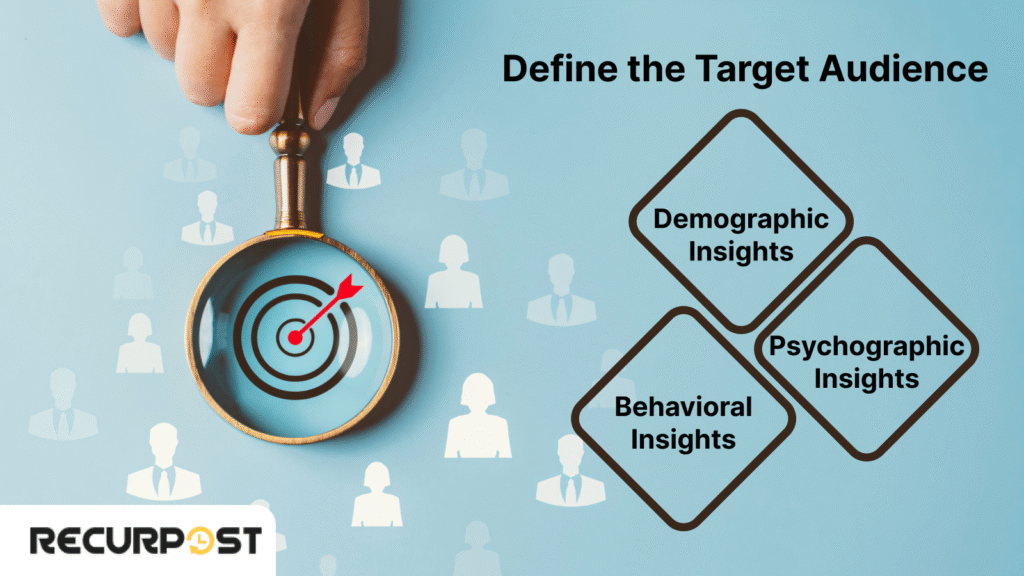
- Demographic Insights: Identify the key demographic details such as age, gender, location, income level, and education. For example, if you’re targeting young professionals, your content should align with their interests and social media habits.
- Psychographic Insights: Look beyond demographics to understand the audience’s lifestyle, values, interests, and purchasing behavior. Are they interested in sustainability, technology, or fashion? Knowing these aspects helps create more tailored content that resonates with the audience.
- Behavioral Insights: Understand how the audience behaves online. Do they engage more with video content, infographics, or blog posts? What time of day are they most active on social media? Behavioral insights are crucial for determining the best type of content and when to post.
- Tools for Segmentation: Use tools like Facebook Audience Insights, Google Analytics, and Instagram Analytics to break down the audience into specific segments. This will help ensure your content reaches the right people, at the right time, on the right platform.
Clearly defined audiences enable the creation of relevant content that drives engagement and conversions.
4. Select the Right Platforms
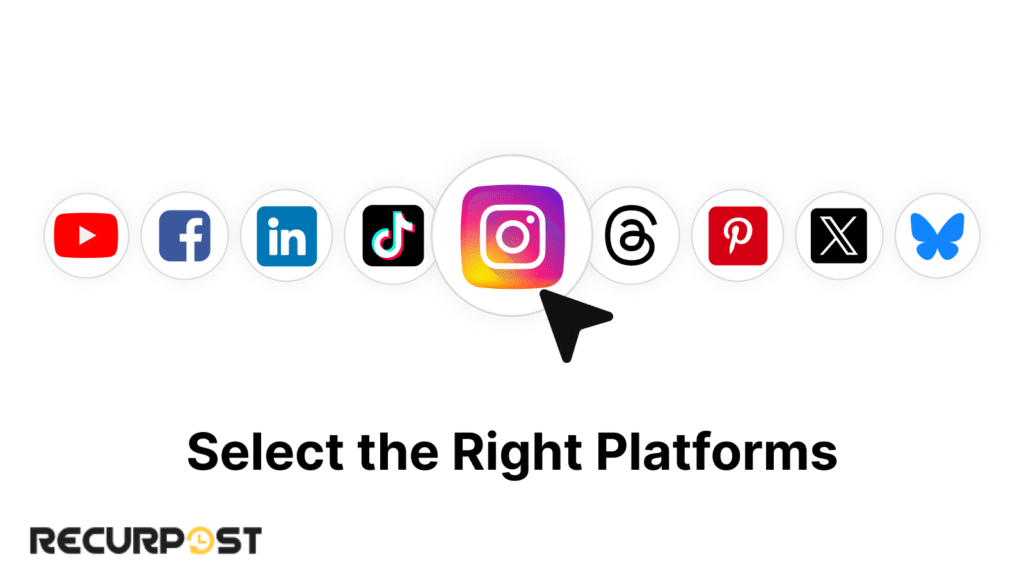
The right social media platforms directly impact campaign success. The platform selection should be based on where the target audience spends their time and the content type that best suits each platform. Here’s how to make the right choice:
- Platform Relevance: Not every platform is suitable for every client. For B2B clients, platforms like LinkedIn and Twitter are ideal for professional networking and industry news. For a lifestyle brand, Instagram and TikTok are better choices due to their visual and interactive nature.
- Content Suitability: Each platform has its strengths. For instance, Instagram excels with visual content, while LinkedIn is ideal for professional, educational, or long-form content. Facebook is great for community engagement and targeted ads, while Twitter is best for quick updates and real-time interaction.
- Resource Allocation: Ensure the client has the capacity to manage the selected platforms effectively. Managing multiple platforms can be time-consuming, so focus on the ones that will yield the best results for the client’s specific goals.
Free Download Instagram Content Calendar
Here’s a comparison chart of popular social media platforms, highlighting their pros and cons:
| Platform | Pros | Cons |
| Ideal for B2B, professional networking, and industry content. Strong for thought leadership. | Not as engaging for visual content or casual interaction. | |
| Twitter/X | Great for real-time updates, trending topics, and short-form content. Excellent for quick engagement. | Character limits and limited visual impact. |
| Excellent for visual content and influencer marketing. High engagement rates with younger audiences. | Primarily focused on younger demographics, may not reach older audiences. | |
| TikTok | Perfect for viral, short-form videos. Great for younger, creative audiences. High potential for brand visibility. | Not suitable for traditional business content or professional networking. |
| Best for community-building, events, and targeted advertising. Large, diverse user base. | Organic reach is limited without paid ads. Over-saturation of content. |
Example: For a B2B client, prioritize LinkedIn and Twitter for thought leadership, while a lifestyle brand may focus more on Instagram and TikTok to engage younger, more visually-driven audiences.
5. Craft a Content Strategy
An effective content strategy forms the core of any social media marketing proposal. This section outlines how content will be developed and distributed to engage the audience:
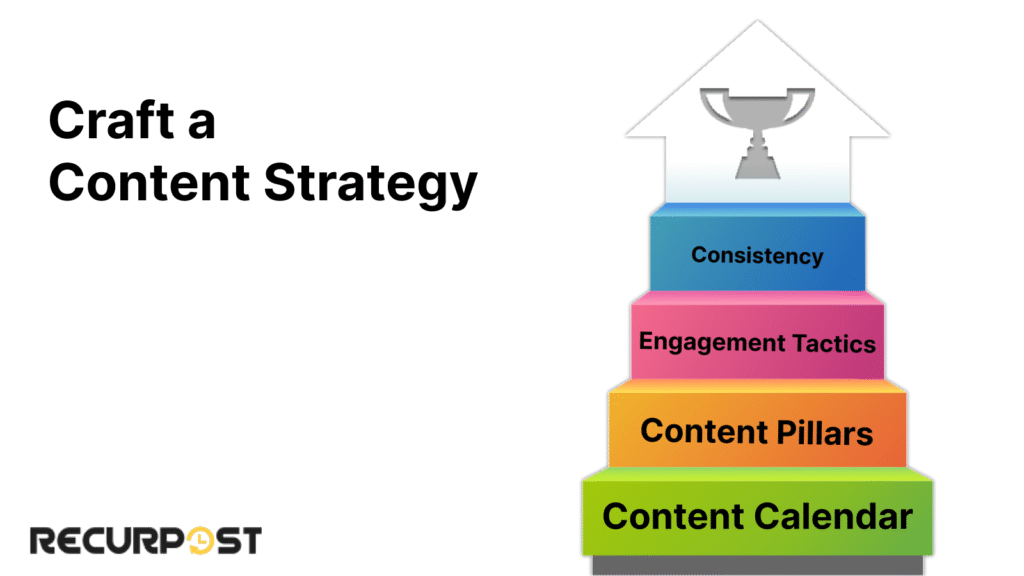
- Content Calendar: Develop a content calendar that organizes content around specific themes, dates, and campaigns. This could include promotional content, user-generated content, blog posts, and behind-the-scenes looks.
Free Download Social Media Content Calendar
- Content Pillars: Define the key content themes that will resonate with the audience. For example, if you’re managing a fashion brand, key themes could be “new collection launches”, “seasonal trends”, and “style tips”.
- Engagement Tactics: Incorporate interactive content like polls, contests, or user-generated content to encourage audience participation. This boosts engagement and fosters a community around the brand.
- Consistency: Maintaining a consistent brand voice and visual identity is crucial. Ensure that the tone, style, and visuals align across all social platforms.
6. Budget & Resource Allocation
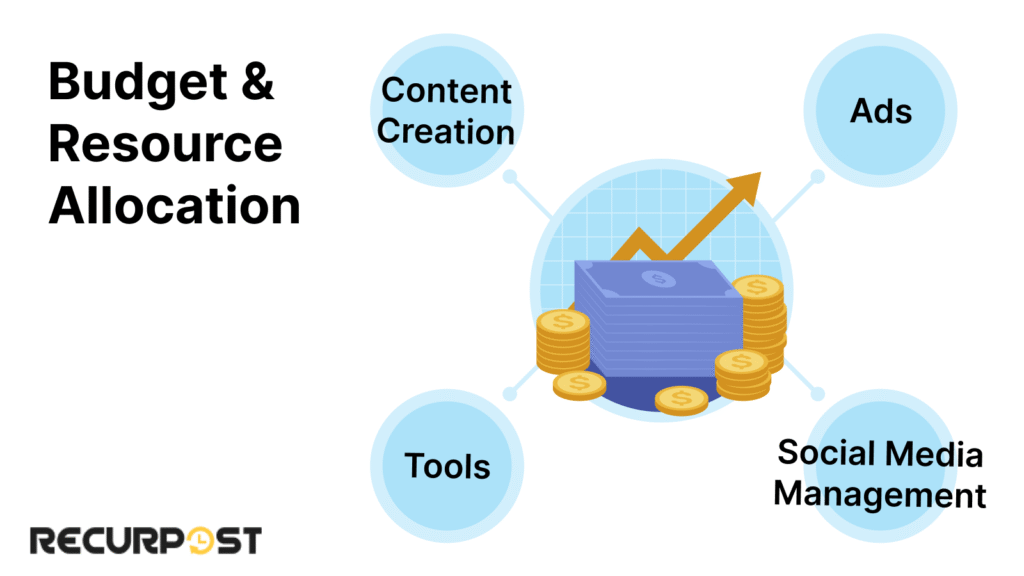
A clear budget breakdown ensures effective resource allocation throughout the campaign. The budget should cover all aspects, from content creation to paid ads:
Allocate Funds: Divide the budget into categories like content creation, advertising, tools, and social media management. This will help you allocate resources based on priority.
Example:
- 40% of the budget for paid ads
- 30% for content creation
- 30% for tools like scheduling software (e.g., Buffer) and analytics tools like Google Analytics to track campaign performance.
7. Establish Key Performance Indicators (KPIs)
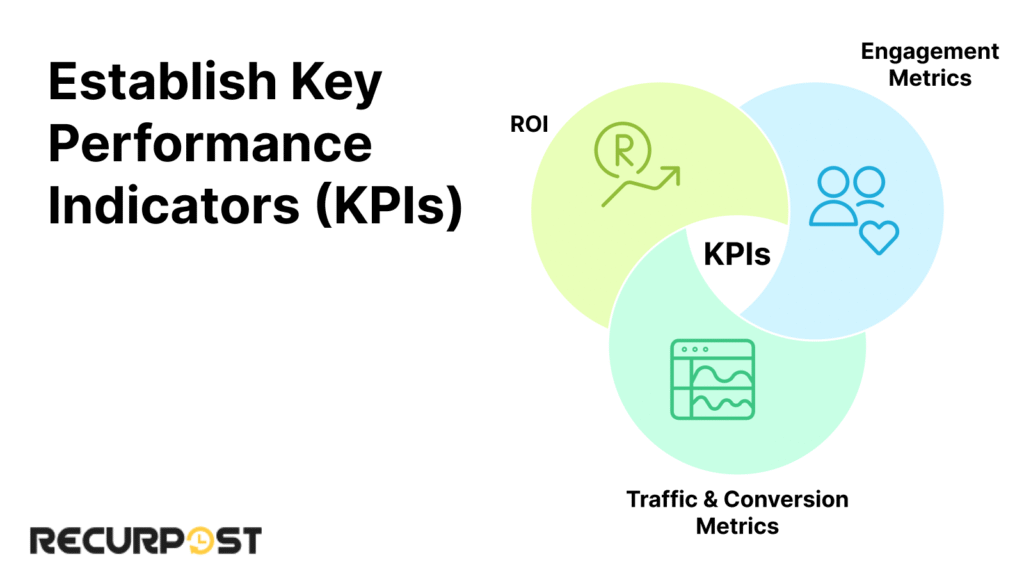
Tracking campaign success requires established KPIs:
- Engagement Metrics: Track likes, shares, comments, and mentions to gauge how well the content resonates with the audience.
- Traffic & Conversion Metrics: Monitor metrics like website visits, click-through rates (CTR), and lead generation.
- ROI: Calculate the return on investment by comparing the campaign’s performance against the budget.
Clear KPIs allow performance monitoring and tactical adjustments when needed.
8. Timeline & Milestones
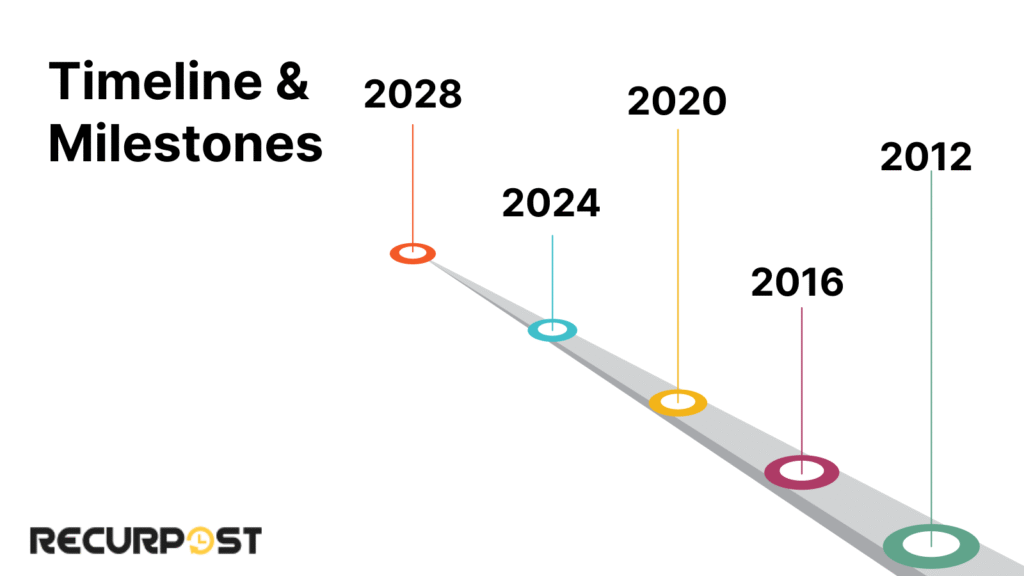
A clear timeline with key milestones ensures the campaign progresses as planned
- Campaign Phases: Break the campaign into stages like planning, content creation, ad execution, and reporting.
- Milestones: Set dates for major tasks like content release, ad launches, and performance reviews.
Example:
- Week 1-2: Content creation
- Week 3: Launch ads
- Week 4: Analyze performance
Create Your Custom Social Media Campaign Proposal

Social Media Campaign Proposal Presentation Tips
A strong social media campaign proposal is key to securing client approval and achieving brand vision. The structure of a proposal for social media management services includes an executive summary, client needs analysis, SMART goals section, target audience definition, platform selection rationale, content strategy framework, budget allocation, KPI establishment, timeline with milestones, and next steps, which you can present using these tips:
# 1 Clarity & Visual Appeal: Keep your social media proposal clear and easy to understand. Use visuals like charts, graphs, and mockups to highlight key points and KPIs. Avoid jargon to ensure the client grasps the strategy and expected outcomes.
#2 Customization & Engagement: Tailor the proposal to the client’s specific target audience and social media channels. Use storytelling to make the proposal more relatable, focusing on how your social media campaign will meet their business objectives and drive visibility.
#3 Data-Driven Insights: Support your social media strategy proposal with social media analytics and case studies that show past success. This builds trust and demonstrates how your approach will enhance engagement, web traffic, and other important metrics.
#4 Clear Executive Summary: Start with a concise executive summary that outlines the campaign strategy, social media goals, and expected results. This helps the client quickly grasp the social media proposal’s main points.
# 5 Actionable Next Steps: Conclude with clear next steps, outlining how the client can move forward with the social media marketing proposal, ensuring a smooth transition to execution.
# 6 Consistent Branding: Maintain consistent branding throughout the social media proposal to reinforce professionalism and increase its visual appeal, making it more likely to gain approval.
Final Thought
A strong social media campaign proposal functions as a strategic tool that helps clients visualize success and connects your efforts with their business objectives. Focusing on appropriate goals, audience insights, and effective platforms creates a campaign that drives brand visibility, increases engagement, and achieves measurable results. A strategic social media marketing proposal can drive long-term business growth for your clients.
Frequently Asked Questions
1. What is the difference between a social media marketing proposal and a social media campaign proposal?
A social media marketing proposal focuses on long-term strategies for managing a brand’s online presence, while a social media campaign proposal is a targeted, short-term plan aimed at achieving specific goals like increasing brand visibility, boosting website traffic, or improving engagement metrics.
2. How can I use a social media proposal template to create my own campaign proposal?
You can access a social media strategy proposal template through our downloadable resources, which provide a structured outline that helps you organize the key elements of the campaign including goals, audience analysis, platform selection, content strategy, and performance metrics.
The key components of a social media marketing proposal template include executive summary sections, client needs analysis frameworks, SMART goals templates, target audience definition guides, platform selection matrices, content strategy outlines, budget allocation charts, KPI tracking sheets, and timeline templates, which you can customize by adding specific goals, strategies, and KPIs that align with the client’s business objectives and audience.
3. What are the most common mistakes to avoid when creating a social media campaign proposal?
Some common mistakes include being too vague about campaign goals, failing to align the social media proposal with the client’s business objectives, or not using data to back up your proposed strategies. It’s also important to ensure that the social media proposal document is tailored to the client’s audience and includes clear next steps.
4. How do I define the target audience for a social media campaign proposal?
To define the target audience, analyze demographic data (age, gender, location) along with psychographic factors (interests, behaviors) and analytics. This allows you to tailor the social media campaign to the right platforms and create content that resonates with the audience.
5. How do I track the success of a social media campaign once the proposal is approved?
After the social media proposal is approved, monitor performance using analytics tools. Track engagement metrics, website traffic, conversion rates, and other key performance indicators (KPIs). This data will help you measure success and adjust the campaign strategy if needed to ensure the campaign goals are achieved.

Ruchi Dhimar is a skilled content writer with 4 years of experience. She is passionate about crafting compelling narratives, specializing in writing content for different industries.
